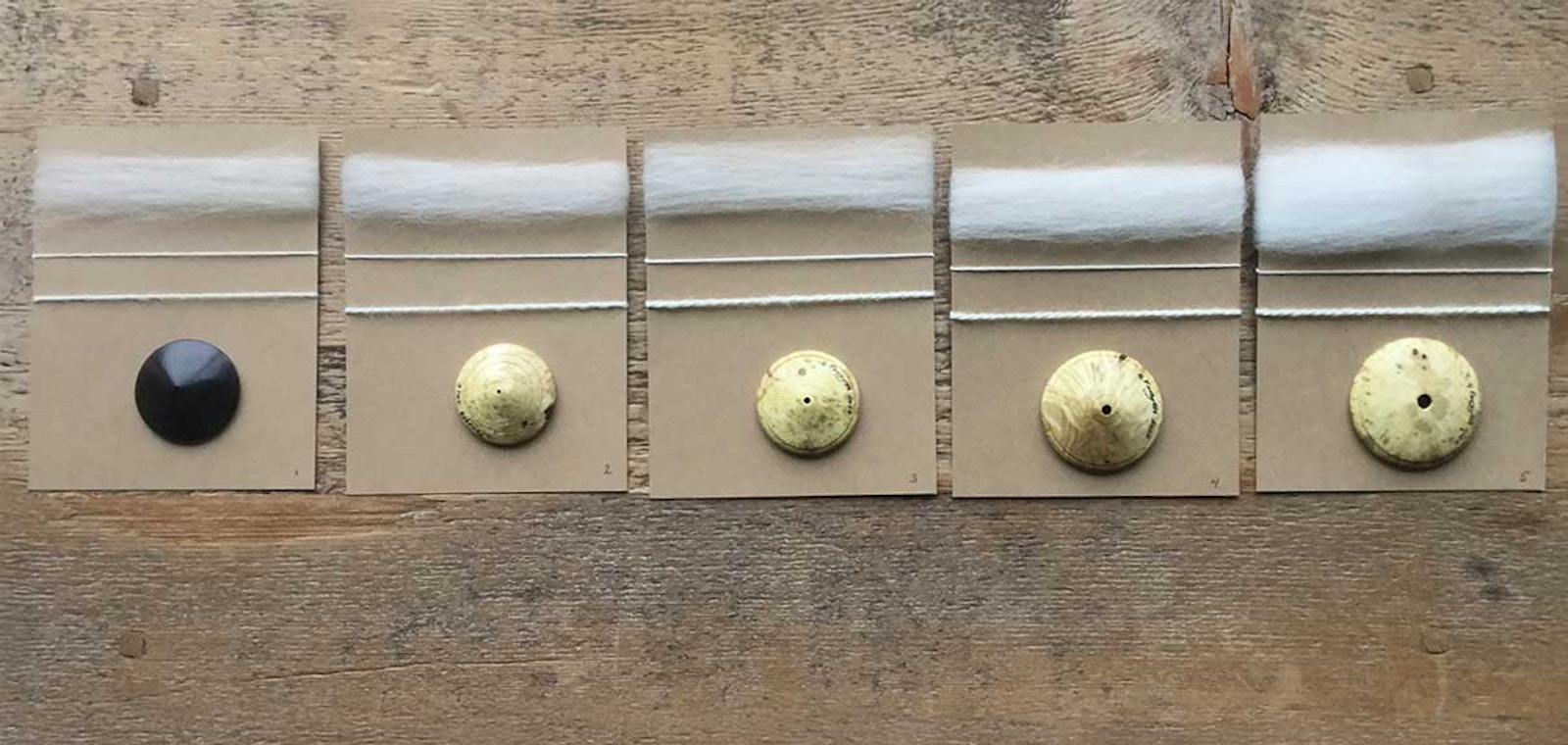Contents
A diz is a tool used to help remove a length of fiber, called a sliver, from your wool combs or a hackle. A button, a sewing-machine bobbin, the rounded corner cut from a milk jug, a shell, a piece of wood, or anything else with a hole in it could be used as a diz. Any of these items can be used to create a tape of fiber to spin from. However, if you are planning to do a significant amount of combing and dizzing, it is nice to work with a well-designed tool that is efficient and not cumbersome and one that helps you work at a relatively swift pace. As I will explain, the design of a diz not only affects the ease of executing the task of dizzing fiber, it can also change the character of the resultant sliver and, in turn, the end product—your yarn.
The Elements of a Diz
The five dizzes I use have the following features in common: They are all lightweight and no larger than 2 inches in diameter. They have a smooth, centered orifice that’s hollowed out into a concave or bowl shape. A diz with these features makes it easier to create a uniform sliver—one that is consistent in fiber density and that has very few thick and thin spots.
The curvature of the diz affects the density of the sliver pulled from the combs. The higher the curvature, the denser the sliver.
To help the diz glide along the sliver as you work, the design should include a smooth orifice. To reduce resistance even further, the material around the lip of the orifice should thin out so the fiber works through a shallow, as opposed to a deep, channel.
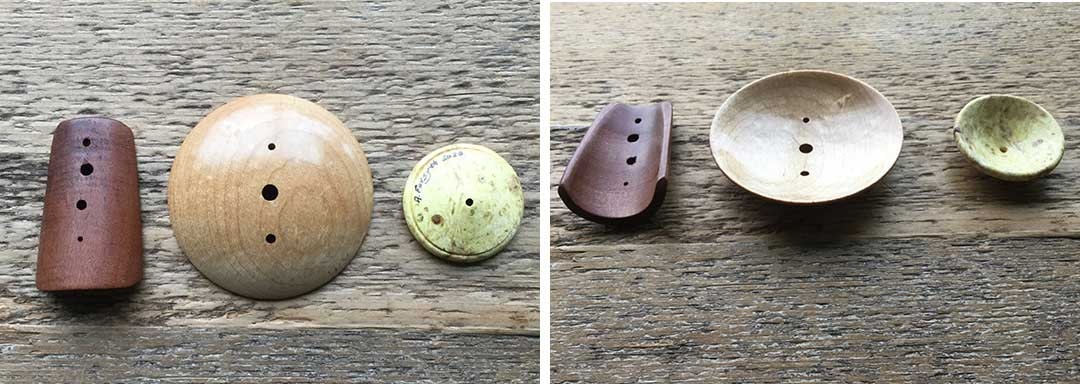 Note the different degree of curvature of the dizzes.
Note the different degree of curvature of the dizzes.
The Benefit of Variety
I regularly use five dizzes. Why five? Each of the dizzes has a different size of orifice. In knitting-needle gauge terms, the orifice sizes are 5.0 mm, 3.25 mm, 2.25 mm. 1.5 mm, and smaller than 1.5 mm. I select a larger size for the first pass, and for the second dizzing (see “Wool Combing & the Importance of Planking,” Spin Off Fall 2020, the one I choose depends upon the diameter of yarn I want to spin. The finer the yarn, the smaller the orifice.
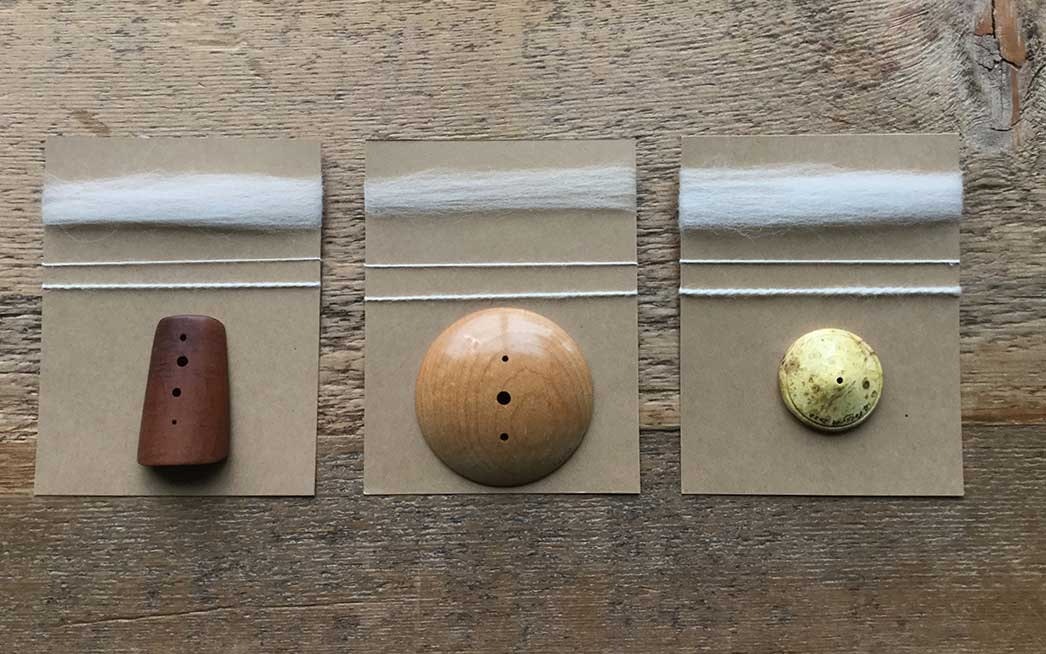 The left diz’s bottom orifice, the middle diz’s top orifice, and the orifice of the diz on the right are all 1.5 mm. The differences in the sliver correlate to the degree of the curvature. The higher the curvature, the denser the sliver.
The left diz’s bottom orifice, the middle diz’s top orifice, and the orifice of the diz on the right are all 1.5 mm. The differences in the sliver correlate to the degree of the curvature. The higher the curvature, the denser the sliver.
Why Weight and Balance Matter
A diz that is lightweight and not too broad negates the need for me to use one hand to support the diz as I pull the fiber into a sliver. Having both hands working in unison makes the action of dizzing smooth, effortless, and quite quick—see Kate Larson’s web post and how-to video, “Diz Tips: The Finer Points of Wool Combing" for more.
Although my dizzes are round with one centered orifice, any shape with any number of orifices can work so long as the diz is nicely balanced during dizzing. If the orifice is off center and heavier to one side, it can flop downward while you work, necessitating one hand being relegated to the job of supporting the diz to counter the extra weight pulling down on and thinning out the sliver. Not only will this slow you down, it will also be more challenging to diz off a nice, even fiber preparation.
Which Direction Should the Diz Face?
I work with the concave surface, the inward curve, of the diz facing the combs. When dizzing in this manner, there is less resistance; the dizzing action is smooth; it is easy on the hands, requiring only a gentle pull to draft the fiber; and it results in a less dense sliver. If you use the same diz and orifice with the convex surface, the outward curve, facing the combs, you will feel resistance as you push the diz toward the combs. To me it feels like I am going “against the grain.” The diz will not glide along the sliver as smoothly, and the sliver produced is slightly denser. It is also harder on the hands because it requires a firmer tug to draft out the tape of fiber.
Also, which face of the diz you have pointed toward the combs when dizzing affects the character of the sliver. When I position the diz so that the inward curve faces the combs, it results in a less dense fiber preparation and one that spins into an airy, lighter-weight yarn. When I diz with the outward curve facing the combs, it results in a denser sliver and a slightly more compact yarn. Once spun, both slivers may result in yarns that are very close in grist, but the hand and density are notably different.
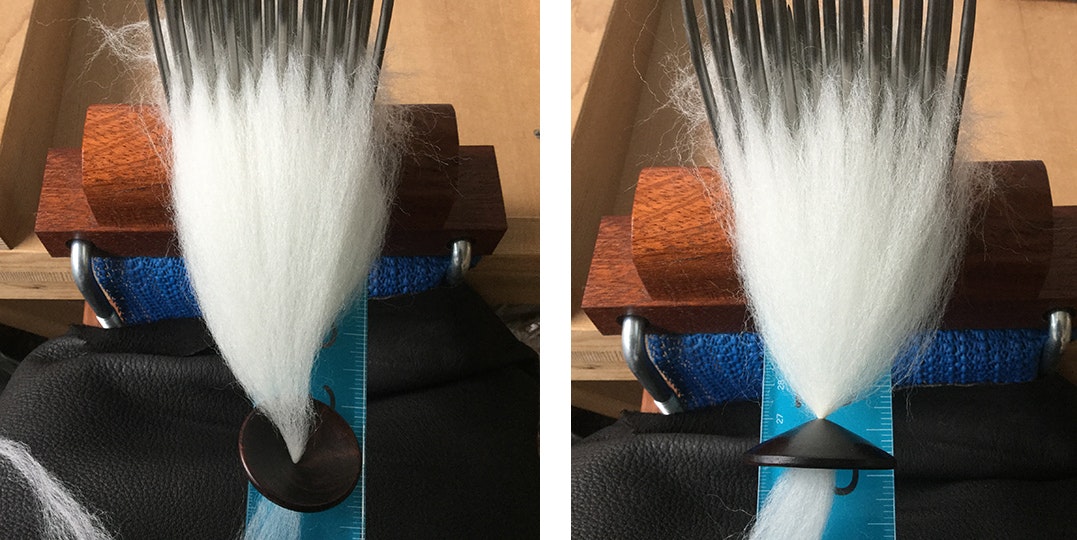 Left: Inward curve facing the combs. Right: Outward curve facing the combs.
Left: Inward curve facing the combs. Right: Outward curve facing the combs.
The differences mentioned here are most noticeable when working with a diz with a very small orifice. When writing this article, I wanted to find a way to confirm what my eyes and hands knew to be true. So, I decided to measure the handspun from each sliver preparation with a McMorran Balance. The handspun from the sliver made with the concave surface (inward curve) of the diz facing the combs measured 2,300 yards per pound (ypp). The handspun from the sliver made with the convex surface (outward curve) facing the combs measured 1,700 ypp.
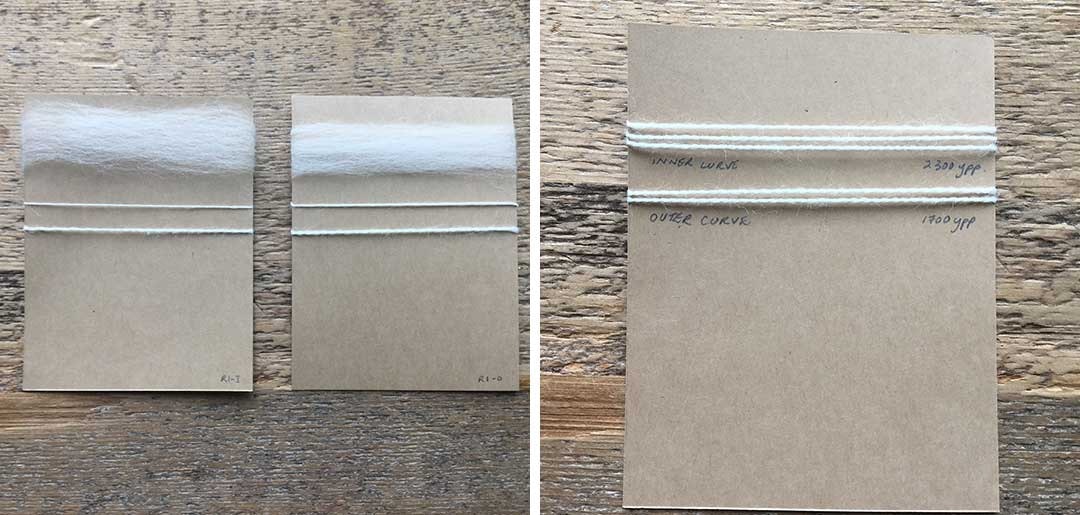 Left: Slivers made using the same orifice from both the concave and convex surfaces. The sliver on the left was dizzed with the concave surface, inner curve, facing the combs. The sliver on the right was dizzed from the combs with the convex surface, outer curve, facing the combs. Right: Kim decided to measure the two yarns with a yarn balance. The yarn spun from the sliver made with the inward curve of the diz facing the combs measured 2,300 ypp (top) and the yarn spun from the sliver the sliver made with the outward curve facing the combs measured 1,700 ypp (bottom).
Left: Slivers made using the same orifice from both the concave and convex surfaces. The sliver on the left was dizzed with the concave surface, inner curve, facing the combs. The sliver on the right was dizzed from the combs with the convex surface, outer curve, facing the combs. Right: Kim decided to measure the two yarns with a yarn balance. The yarn spun from the sliver made with the inward curve of the diz facing the combs measured 2,300 ypp (top) and the yarn spun from the sliver the sliver made with the outward curve facing the combs measured 1,700 ypp (bottom).
How to Select Your First Diz
My advice for anyone who wants a diz that is efficient and easy to work with is to choose a lightweight, well-balanced diz with a concave/bowl-shape. Make sure it is of a manageable diameter, not too big or too small, for your hands. It should be both comfortable to hold and to maneuver. As for the orifice? The lip should be thin and smooth and the channel shallow. Each yarn in first image at the beginning of this article was spun using the same ratio and draft length. The difference in grist/diameter is simply a function of my choice of orifice size. So, when you choose a diz, don’t forget to take into account the diameter of yarn you want to spin.
Happy Dizzing!
Resources
- Find Kim's article, “Wool Combing & the Importance of Planking,” in the Fall 2020Spin Off issue.
- Watch Kate Larson's how-to video in “Diz Tips: The Finer Points of Wool Combing.”
Originally published January 1, 2021, updated September 3, 2025.

